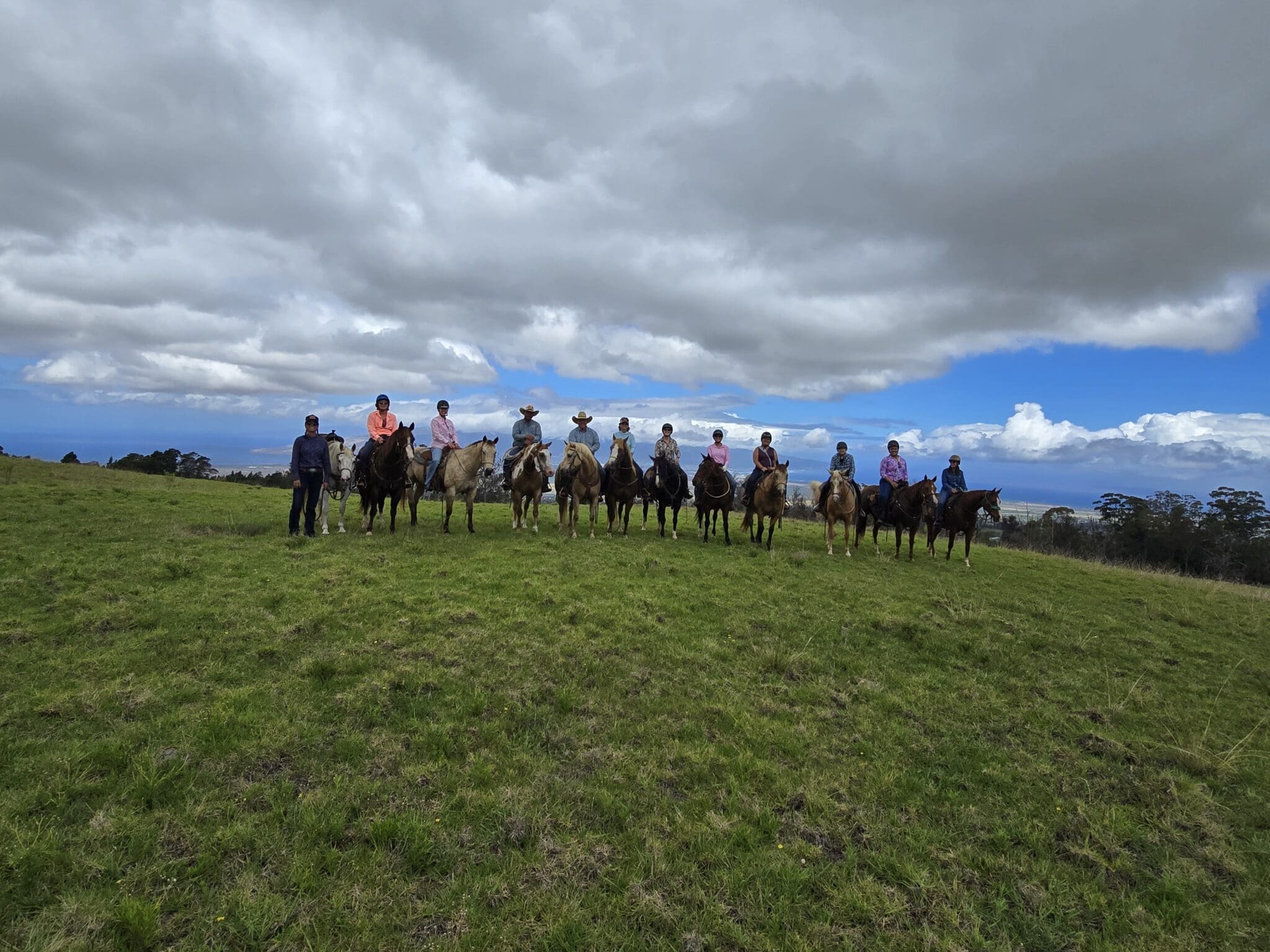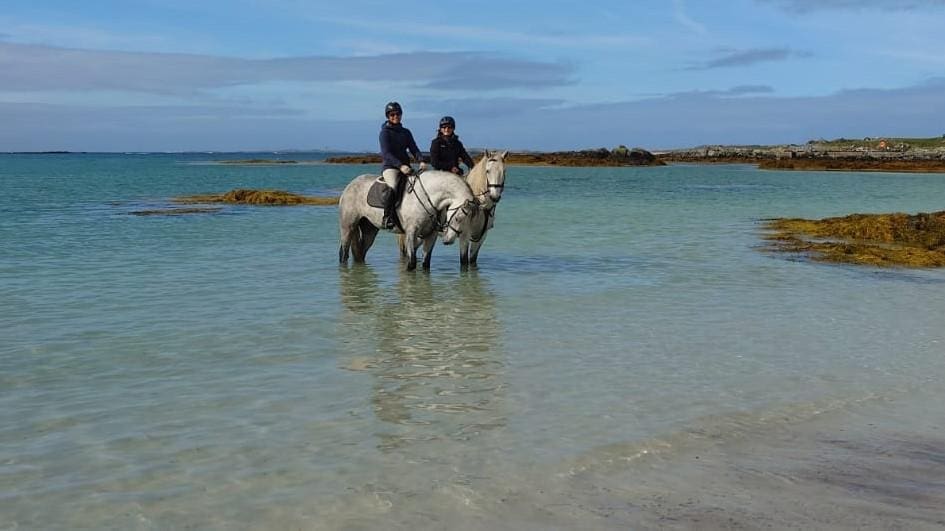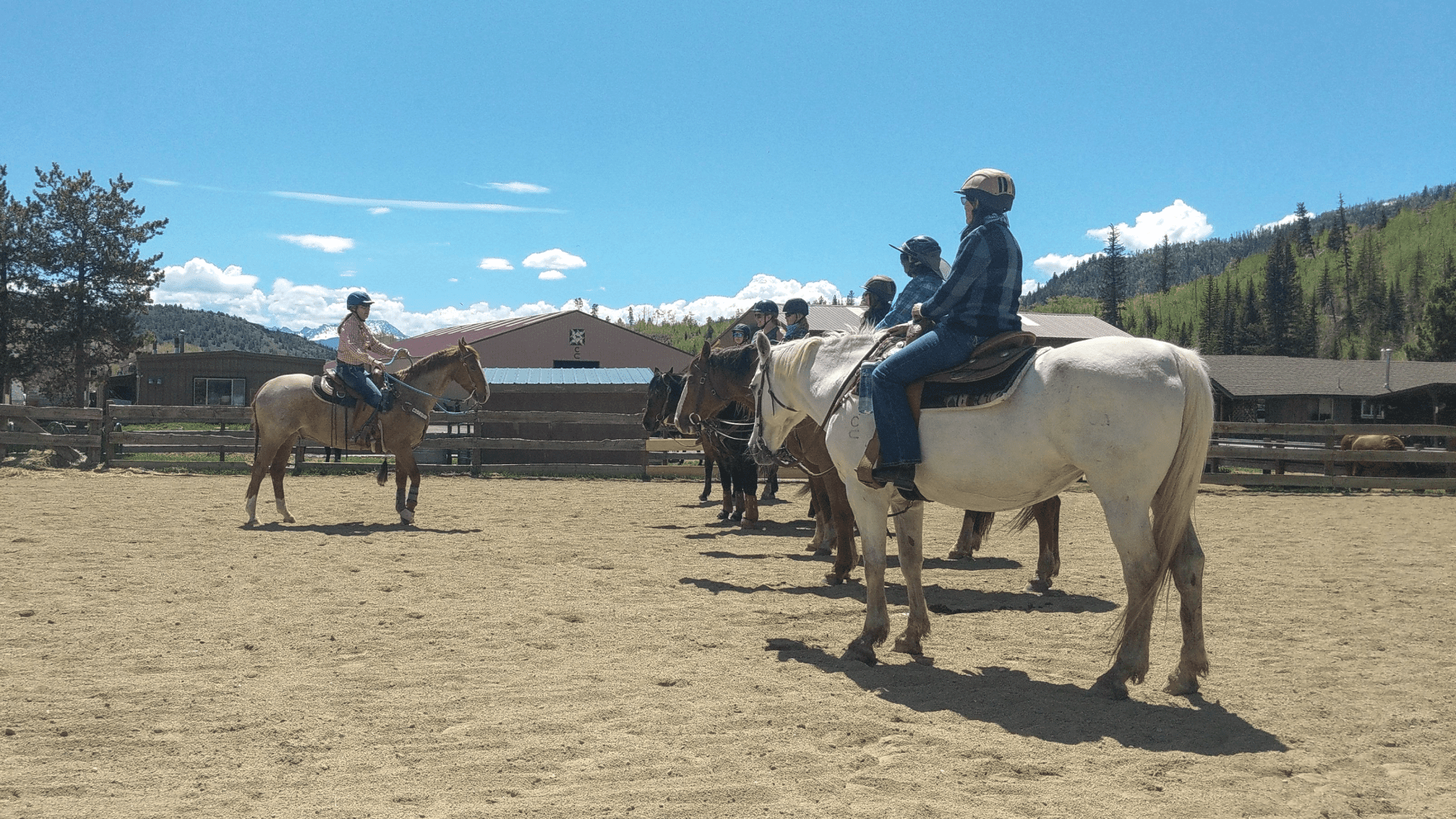RIDE RIGHT WITH JULIE GOODNIGHT
Ground-Work Exercises
Hone your horse’s manners and your leadership skills over the winter for a better ride in the spring with these tips from top trainer/clinician
Unless you’re in the Sunbelt, winter means less trail-riding time and more turnout for your horse. Until the ground thaws, you’ll need to keep him focused on you with targeted ground-work exercises.
The more you work with your horse over the winter, the more he’ll be focused on you when it’s time for more saddle time in the spring.
Plus, you’ll keep up your own horsemanship skills and learn to be aware of how your body position and sequencing of cues help your horse to learn quickly and easily. You’ll then be able to teach your horse most anything for great trail rides.
Here, top trainer/clinician Goodnight will first explain how the herd mentality your horse can develop in winter turnout can present training challenges.
Then Goodnight will give you three ground-work exercises to work on throughout the winter to keep your horse looking to you as his herd leader: (1) Practice body awareness; (2) teach the standstill; and (3) teach leading manners.
Goodnight will also provide a rope-halter-tying tip that kids can practice inside this winter.
The Herd Mentality
When your horse is turned out for the winter, he may quickly revert to a herd mentality. In that mode, he’ll follow the herd’s cues, rather than keep tuned in to your leadership.
“You may undermine instead of boosting your leadership if, in the winter, your horse is turned out with his buddies and you only see him at feeding time, or when you step in to rub on him and bring him treats,” says Goodnight.
“It’s not that you’re never going to hug on your horse or love on him, but respect has to come first. Think about how you’re interacting with him every time you’re near him.”
How long does it take a horse to be turned out and become part of the big herd instead of part of your horse-and-human herd of two?
Goodnight says that as horses approach middle age, they may become more herd-bound, but individual horses react differently with more or less time away from work.
To be safe, perform ground work all year long to help keep your horse looking to you for leadership. He’ll continue to be (or will become) a respectful partner who looks for your leadership and permission.
Before You Begin
You can do ground work in a small space — in your barnyard or even inside the barn. You need only a small, fairly level area with good footing.
Outfit your horse in a rope halter and a long training lead with a rope-to-rope connection at the halter. A rope halter better translates your cues than a flat nylon halter does.
Over the winter, do these exercises as often as possible. Once per day is ideal, but once per week or even once per month is much better than not working with your horse at all.
Exercise 1: Practice Body Awareness
This body-awareness exercise helps your horse tune in to your body/sign language, and begin to have more deference for your leadership — and your personal space.
A horse’s spatial awareness is acute — he has a greater appreciation for body/sign language than humans do. It’s your job to mind your position and body language and make sure that you’re aware of your posture and consistent cues.
Step 1. Define your personal space. Every time you’re near your horse, stretch your arms out around you in all directions. That’s your space — space your horse shouldn’t enter without permission.
Free yourself of the need to be in your horse’s space all the time. That’s satisfying for you, but not helpful for your relationship with him. If you enter your horse’s space all the time — kissing and hugging — your horse won’t have a clear idea about your personal boundaries.
While you sometimes want to love on your horse, start with a clear boundary. Only allow that closeness after you have set up a clear expectation of his space and yours.
Step 2. Practice your body language. Practice submissive and more aggressive postures in front of a mirror.
If your shoulders are rounded, your toes are pointed away, and your eyes are diverted, you’ll appear unthreatening to your horse.
If your shoulders are up, your chest is puffed, your chin is high, and you look straight at your horse, he’ll take that as an aggressive or admonishing posture.
Match your body language to the situation; always be aware of when and how you’re moving.
Adopt less threatening body language if you want to give your horse a break and not be reactive to your every move (or help him know you’re not an aggressor when you’re trying to catch him).
Appear active and confident when you get ready to move with your horse.
Exercise 2: Teach the Standstill
When you get back in the saddle this spring, you’ll want to know that your horse will stand still. This is an important trail skill.
You’ll want your horse to stand still for mounting, and in case you need to hop off to help another rider. The standstill also is the basis for learning to ground-tie.
Learning to stand still also reminds your horse to focus on you and get in the habit of reacting to your cues, rather than looking for something else to focus on — and possibly spook at.
Your horse needs to look at you and think before making a move. Teach this mind-set on the ground, and this lesson will carry over to your under-saddle time in the spring.
Add the command “whoa,” and you’ll teach your horse to stop and focus on you no matter where you are.
When you’re on the trail, this command will solidify your horse’s ability to focus on you. If he does spook when you’re riding, he’ll know that “whoa” means “stop now.” You’ll program in a command that may keep him from running off. Instead, he’ll focus on you.
Note: If your horse has been confined, start with another exercise that allows him move around. If he’s turned out all day, this is a great place to start.
Step 1. Place your horse. Ask your horse to stand still like a statue and not move a hoof without your permission. Place him where you’d like him to stand, then turn, and face him. Avoid standing too close. You don’t want to hold him still; you want him to know that he must listen and choose to stand still.
Step 2. Move away. Stand about six feet away, and point your toes toward his left shoulder. Make sure you’re not standing directly in front of him, but just off to the left side of his body.
Step 3. Correct him. If your horse moves a hoof or turns his head so that his nose passes his shoulders, issue an immediate correction by sending a wave through the lead rope so that it puts pressure on the rope halter. Use the amount of pressure needed to get his attention. Some horses need only a small movement of the rope to remind him to listen; others need more pressure.
Your horse will quickly learn that every time he moves a foot without your authorization, he’ll get in trouble. He should learn this lesson quickly, in the very first session, if your timing and corrections are effective.
Step 4. Heighten the challenge. When your horse obeys, heighten the challenge. Step farther and farther away. Eventually, lay the middle of the rope on the ground while you hold the end. Even if you only ask him to stand for 30 seconds, you’ll strengthen your relationship as your horse looks to you to know what to do and how to act.
Step 5. Teach the ground-tie. When your horse is listening well, lay down the rope, and teach him to stand still with the rope on the ground. Work up to 10 to 15 minutes of practice a day, and you’ll have a horse who can successfully ground-tie before spring.
Step 6. Increase the challenge further. Ask your horse to stand still when he’s antsy, such as before it’s time for turnout or when other horses are moving into the barn to eat. He needs to listen to you no matter what the horse herd is doing around him. When he knows the lesson, it won’t matter how much energy he has — he’ll stand still when asked.
Exercise 3: Teach Leading Manners
Leading manners are paramount on the trail. You might find yourself riding in an uncontrollable environment and need to dismount. You might need to dismount, and lead your horse across difficult terrain. You might need to pony your horse.
If your horse will obediently follow you when you lead him, you’ll likely both stay safe on the trail, even a narrow one carved into a sheer cliff.
With this exercise, sequence your cues, so that you always do the same thing in the same order, step-by-step: Look up, lean your shoulders forward; move your feet; pull on the lead, if necessary.
When you sequence your aids, your horse will quickly learn and respond. You’ll carry the leadership role that you’ll develop practicing this exercise into your spring riding.
Here’s how to apply this sequencing to teaching your horse how to maintain a respectful position as you lead him.
Step 1. Gain his focus. You’ll first need to teach your horse to focus on your movements and maintain a position on your side, regardless of your speed and direction. He’ll need to learn to stay in the correct position and within the acceptable boundaries. He shouldn’t move into your space or ahead of you. To gain his focus, move deliberately, and be consistent with your body language.
Step 2. Walk on. To initiate the walk, lean your shoulders forward; this tells your horse you’re about to move. Then move your feet, and say “Walk on!” or cluck to him. Give him these cues before you pull on the lead.
Step 3. Apply lead-rope pressure. If your horse doesn’t walk when you give him the above cues, reinforce them with lead-rope pressure. Lean your body weight into the rope if necessary.
Step 4. Release lead-rope pressure. As soon as your horse takes one step forward, release the lead-rope pressure, and continue walking. Hold the lead loosely so that he learns to follow your body language without expecting a pull. You want to teach him to move with you, not depend on constant lead-rope pressure.
Step 5. Correct him, if necessary. As you walk your horse, don’t let his nose move past your lead hand, and definitely don’t let his shoulder move past yours. If he crosses the boundary, snap back hard on the lead rope, turn around and face him, stomp your feet, flap your arms and back him up while admonishing him with your voice.
Use the amount of pressure that causes your horse to think: What did I do wrong? What can I do so that doesn’t happen again?
Some horses may only need you to turn and look at him sternly; other horses may need more pressure. If your horse falls into the latter category, stop, turn, and back him up a few steps with authority.
If you use enough pressure and good timing, your horse will very quickly learn the precise place he should be. Soon, he’ll learn that the moment you lean forward, he better be ready to move.
Tip: If you find yourself constantly pulling or initiating a correction multiple times, check to make sure your corrections are consistent. Slightly escalate the pressure, and add a verbal admonishment.
Step 6. Don’t hold him back. Don’t pull back on the lead rope to hold your horse back. If you pull on the lead all the time, he’ll forever rely on that pressure to tell him where to be. Instead, give him the responsibility to keep himself in the proper place, using the correction outlined in Step 4.
Step 7. Regulate his speed. If your horse lags behind your walking pace, change your body language. When you move your shoulders forward then move your feet, your horse should step with you. If you have to also pull on the lead rope, bring your arms in close to your body and lean forward hard on the rope.
If you lean forward quickly as a correction, not as a constant pull, you’ll teach your horse to pay attention to the body language that came first instead of waiting for the pull.
Tip: Avoid turning and swatting your horse with the end of the lead rope to propel him forward. This action can confuse him, because you’re actually turning around and changing your direction. Simply continue the correction outlined in Step 4.
Step 8. Change direction. At the walk, ask for a change of direction. To turn, simply walk toward the direction you want to go. Be sure to move your horse away from you and out of your space; don’t pull him toward you.
If your horse doesn’t move, pick up your hands, stomp your feet and defend your space by waving your hands just behind your horse’s eye without touching him.
Step 9. Ask for the trot. To pick up the trot, lean your shoulders forward, then start trotting while saying “Trot!” If he starts to trot, praise him. Then go back down to the walk, and ask for the trot again. Just trot straight lines; don’t trot around turns.
Step 10. Change it up. Escalate the challenge by changing speeds, turning, then turning at different speeds and degrees. Soon, you’ll be able to walk in all directions with little to no pressure on the lead rope and only with your body language.
Step 11. Use just a neck rope. If your horse leads well with the halter and lead rope, try working with him in a safe, enclosed area with just a neck rope. With this gear, you can test your horse’s obedience while maintaining a way to correct him, if needed. [BUG]
For more training tips from Julie Goodnight, and to access her free online library, go to Julie Goodnight Academy
For more information on equine behavior, click on: Goodnight’s Guide to Great Trail Riding, with bonus DVD.
For more information on Horse Behavior, click on Speak the Language: Horse Behavior (Streaming) or Speak the Language: Horse Behavior (DVD)
JUST FOR KIDS
How to Tie a Rope Halter fasten/put on? Does this sound like you are going to make a rope halter from scratch?
Rope halters are great training tools, but unlike nylon and leather halters, you need to tie them onto your horse’s head. This can be a challenge for anyone.
Julie Goodnight says she often sees rope halters tied with an incorrect knot. She also sees halters with the tail aimed toward the horse’s eye instead of his rear end.
Practice tying a rope halter correctly, so when you catch your horse, you can secure him quickly and get the knot undone easily. A correctly adjusted and tied halter will also translate your lead-rope cues more precisely to your horse than a sloppy halter will
Practice haltering a stuffed horse, or have a friend hold the halter as if it were on your horse’s head.
Here’s how to tie the halter knot:
> Adjust the halter so that the throat knot is all the way up to the horse’s throat.
> Bring the length that comes down from the crownpiece (the part that lies behind your horse’s ears) down through the halter’s loop on the left-hand side of his face.
> Tie this length around the bottom part of the loop, making a figure-eight.
> Make sure the excess length is pointed toward your horse’s tail.
> Watch Goodnight tie a rope halter on this YouTube.com video: http://tinyurl.com/prn3pe5.



